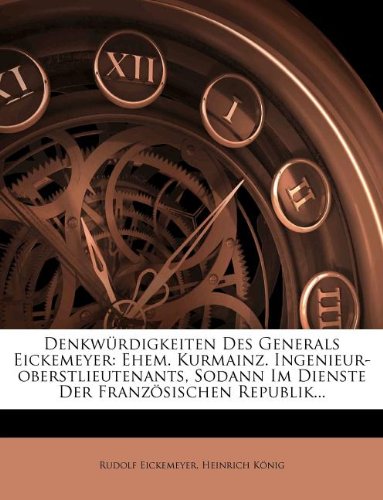Background
Rudolf Eickemeyer was born in Altenbamberg, Bavaria, Germany, the son of Christian and Katherine (Brehm) Eickemeyer.



(This book was originally published prior to 1923, and rep...)
This book was originally published prior to 1923, and represents a reproduction of an important historical work, maintaining the same format as the original work. While some publishers have opted to apply OCR (optical character recognition) technology to the process, we believe this leads to sub-optimal results (frequent typographical errors, strange characters and confusing formatting) and does not adequately preserve the historical character of the original artifact. We believe this work is culturally important in its original archival form. While we strive to adequately clean and digitally enhance the original work, there are occasionally instances where imperfections such as blurred or missing pages, poor pictures or errant marks may have been introduced due to either the quality of the original work or the scanning process itself. Despite these occasional imperfections, we have brought it back into print as part of our ongoing global book preservation commitment, providing customers with access to the best possible historical reprints. We appreciate your understanding of these occasional imperfections, and sincerely hope you enjoy seeing the book in a format as close as possible to that intended by the original publisher.
https://www.amazon.com/Letters-Southwest-Rudolf-Eickemeyer/dp/B00B396ALK?SubscriptionId=AKIAJRRWTH346WSPOAFQ&tag=prabook-20&linkCode=sp1&camp=2025&creative=165953&creativeASIN=B00B396ALK

( This is a reproduction of a book published before 1923....)
This is a reproduction of a book published before 1923. This book may have occasional imperfections such as missing or blurred pages, poor pictures, errant marks, etc. that were either part of the original artifact, or were introduced by the scanning process. We believe this work is culturally important, and despite the imperfections, have elected to bring it back into print as part of our continuing commitment to the preservation of printed works worldwide. We appreciate your understanding of the imperfections in the preservation process, and hope you enjoy this valuable book. ++++ The below data was compiled from various identification fields in the bibliographic record of this title. This data is provided as an additional tool in helping to ensure edition identification: ++++ Denkwürdigkeiten Des Generals Eickemeyer: Ehem. Kurmainz. Ingenieur-Oberstlieutenants, Sodann Im Dienste Der Französischen Republik Rudolf Eickemeyer, Heinrich König Literarische Anstalt. (J. Rütten), 1845 History; Europe; France; History / Europe / France
https://www.amazon.com/Denkw%C3%BCrdigkeiten-Generals-Eickemeyer-German-Eickemeyer/dp/1247747077?SubscriptionId=AKIAJRRWTH346WSPOAFQ&tag=prabook-20&linkCode=sp1&camp=2025&creative=165953&creativeASIN=1247747077
Rudolf Eickemeyer was born in Altenbamberg, Bavaria, Germany, the son of Christian and Katherine (Brehm) Eickemeyer.
He was educated in his village schools, the Realschule at Kaiserlautern, and the Polytechnic Institute at Darmstadt, where he completed his studies at the age of seventeen.
He joined the insurgents in the Revolution of 1848 with his friend and future partner George Osterheld. After its collapse the two left Germany for New York, arriving November 20, 1850. In the United States they found employment, first in the building of the Erie Railroad, later with the Buffalo Steam Engine Works, and finally, in 1854, settled at Yonkers, New York, where they opened a small machine repair shop. Following the Civil War, during which he converted his plant into a revolver factory and also served a thirty-day enlistment, he perfected and patented in 1870 a differential gear for a mowing and reaping machine which was profitably sold to a Canadian manufactory. He continued, too, to improve his hatting machinery and to devise additional equipment, including a shaving machine and one to make blocks and flanges. Being a most intelligent man, he had all along followed the progress of scientific thought, especially in electricity, and in the seventies when this science came to the foreground, he began some experimental work in telephony, taking out a number of patents. This experimentation was followed by work on armatures and armature windings which resulted in the perfecting and patenting of the first symmetrical drum armature and the iron-clad dynamo. So superior were they to existing equipment that the demand for them was immediate—armatures for motor manufacturers and iron-clad motors for elevators—and by 1884 the hat machinery factory had been largely converted into a prosperous electric plant and laboratory. Eickemeyer continued with experimental work and soon electric-lighting and railway generators and motors were produced. He and Stephen D. Field together developed the first direct- connected railway motor, designing it for use on the New York Elevated Railroad. In addition he made many investigations on hysteresis, high potential phenomena, and alternating-current machinery, devising special instruments for the purpose. In 1892 his business was consolidated with the General Electric Company, but he continued his electrical investigations until his death. He was the discoverer and first employer of the illustrious electrical engineer, Charles P. Steinmetz. He was active in civic affairs in Yonkers: a fireman in his youth; a militiaman for fourteen years; a water commissioner for twenty-two years; and vice-president of the school board, of which he was a trustee for twenty-three years.
(This book was originally published prior to 1923, and rep...)
( This is a reproduction of a book published before 1923....)
Hatmaking was then the chief industry of Yonkers; and through their repair work the partners became familiar with the art, and Eickemeyer began to give serious attention to the improvement of its crude mechanical appliances.
vice-president of the school board, of which he was a trustee for twenty-three years
He married Mary True Tarbell of Dover, Maine, in July 1856, who with six children survived him.
